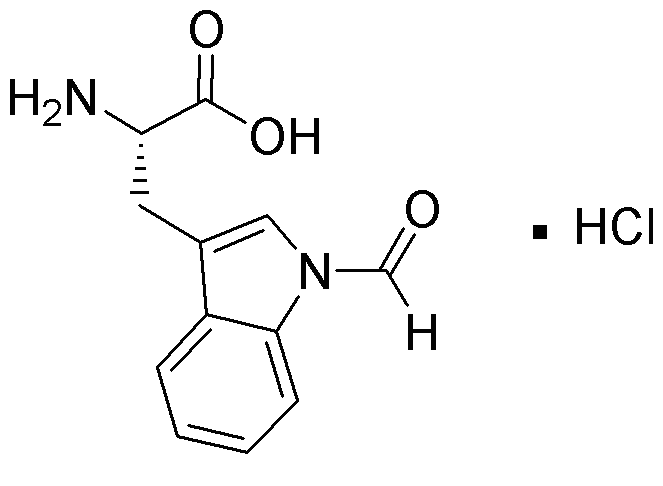Nin-Formyl-L-tryptophan hydrochloride is widely utilized in research focused on:
- Pharmaceutical Development: This compound serves as a valuable intermediate in synthesizing various pharmaceuticals, particularly those targeting neurological disorders, due to its structural similarity to serotonin.
- Biochemical Research: It is used in studies investigating the role of tryptophan derivatives in metabolic pathways, helping researchers understand their impact on human health and disease.
- Peptide Synthesis: This chemical is employed in the synthesis of peptides, where its unique formyl group can enhance the stability and bioactivity of the resulting compounds.
- Antioxidant Studies: Researchers explore its potential antioxidant properties, making it relevant in studies aimed at developing new therapies for oxidative stress-related conditions.
- Food Industry Applications: The compound is investigated for its potential use as a food additive, where it may enhance flavor profiles or nutritional value in specific products.
General Information
Properties
Safety and Regulations
Applications
Nin-Formyl-L-tryptophan hydrochloride is widely utilized in research focused on:
- Pharmaceutical Development: This compound serves as a valuable intermediate in synthesizing various pharmaceuticals, particularly those targeting neurological disorders, due to its structural similarity to serotonin.
- Biochemical Research: It is used in studies investigating the role of tryptophan derivatives in metabolic pathways, helping researchers understand their impact on human health and disease.
- Peptide Synthesis: This chemical is employed in the synthesis of peptides, where its unique formyl group can enhance the stability and bioactivity of the resulting compounds.
- Antioxidant Studies: Researchers explore its potential antioxidant properties, making it relevant in studies aimed at developing new therapies for oxidative stress-related conditions.
- Food Industry Applications: The compound is investigated for its potential use as a food additive, where it may enhance flavor profiles or nutritional value in specific products.
Documents
Safety Data Sheets (SDS)
The SDS provides comprehensive safety information on handling, storage, and disposal of the product.
Product Specification (PS)
The PS provides a comprehensive breakdown of the product’s properties, including chemical composition, physical state, purity, and storage requirements. It also details acceptable quality ranges and the product's intended applications.
Certificates of Analysis (COA)
Search for Certificates of Analysis (COA) by entering the products Lot Number. Lot and Batch Numbers can be found on a product’s label following the words ‘Lot’ or ‘Batch’.
*Catalog Number
*Lot Number
Certificates Of Origin (COO)
This COO confirms the country where the product was manufactured, and also details the materials and components used in it and whether it is derived from natural, synthetic, or other specific sources. This certificate may be required for customs, trade, and regulatory compliance.
*Catalog Number
*Lot Number
Safety Data Sheets (SDS)
The SDS provides comprehensive safety information on handling, storage, and disposal of the product.
DownloadProduct Specification (PS)
The PS provides a comprehensive breakdown of the product’s properties, including chemical composition, physical state, purity, and storage requirements. It also details acceptable quality ranges and the product's intended applications.
DownloadCertificates of Analysis (COA)
Search for Certificates of Analysis (COA) by entering the products Lot Number. Lot and Batch Numbers can be found on a product’s label following the words ‘Lot’ or ‘Batch’.
*Catalog Number
*Lot Number
Certificates Of Origin (COO)
This COO confirms the country where the product was manufactured, and also details the materials and components used in it and whether it is derived from natural, synthetic, or other specific sources. This certificate may be required for customs, trade, and regulatory compliance.


